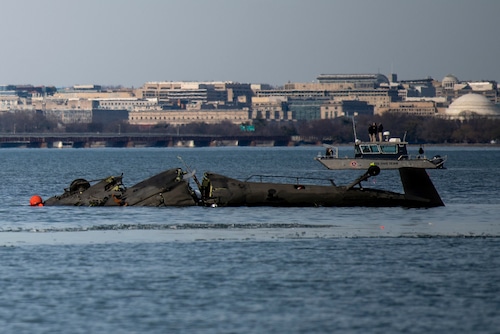By Associated Press’s David R. Martin, Michael R. Sisak, and Claudia Lauer
Five days after a mid-air crash last week that claimed 67 lives, salvage personnel on Monday recovered a significant chunk of a commercial jet from the Potomac River close to Washington’s Reagan National Airport.
According to authorities, removing the jet will take a few days, after which they will attempt to remove the military helicopter that was involved in the collision.
The deadliest U.S. air tragedy since 2001 occurred Wednesday when an American Airlines plane collided with an Army helicopter above Washington, D.C.
Of the 67 persons died in the disaster, authorities have located and identified 55 of them, and Fire and EMS Chief John Donnelly of Washington, D.C., has stated that they are certain that everyone will be found. Early on Monday, crews were spotted on a ship that had a crane.
According to officials, the recovery effort involved approximately 300 personnel at any given moment. Heavy wreckage was also lifted by two Navy barges.
Col. Francis B. Pera of the Army Corps of Engineers stated on Sunday that divers and salvage personnel are following stringent procedures and will cease moving debris if a body is discovered. According to him, the respectful recovery of remains comes first.
Parts of the two planes—an Army Black Hawk helicopter carrying three people and an American Airlines jet carrying sixty-four—that collided over the river Wednesday night near Ronald Reagan Washington National Airport are being loaded onto flatbed trucks and transported to a hangar for examination.
The jet was on its way to land from Wichita, Kansas, when it crashed. The Black Hawk had a mission of training. No one survived.
Family members were escorted by police in busses to the Potomac River shore on Sunday, close to where the two planes came to rest following their collision.
A party of hunters returning after a guided trip and figure skaters returning from the 2025 U.S. Figure Skating Championships in Wichita were among the passengers aboard the plane. Capt. Rebecca M. Lobach of Durham, North Carolina; Chief Warrant Officer 2 Andrew Loyd Eaves, 39, of Great Mills, Maryland; and Army Staff Sgt. Ryan Austin O. Hara, 28, of Lilburn, Georgia, were on the helicopter.
The events leading up to the incident were being pieced together by federal investigators. Usually, thorough investigations take a year or longer. Within 30 days, investigators hope to have a preliminary report.
Since Nov. 12, 2001, when a flight crashed into a neighborhood in New York City shortly after takeoff, killing all 260 passengers on board and five on the ground, Wednesday’s tragedy was the worst in the United States.
Although experts emphasize that flying is generally safe, even seasoned pilots may find it difficult to navigate the congested area surrounding Reagan Airport.
Preliminary data revealed inconsistent readings regarding the airplane and helicopter’s altitudes, the NTSB said on Saturday.
Additionally, investigators reported that the jet’s flight recorder indicated a pitch shift approximately one second prior to crash. However, they made no mention of whether the angle shift indicated that pilots were attempting an evasive maneuver in an attempt to escape the collision.
When the incident occurred, the jet’s altitude was 325 feet (99 meters), plus or minus 25 feet (7.6 meters), according to data from its flight recorder, NTSB officials told reporters. However, the Black Hawk was at 200 feet (61 meters), the highest altitude permitted for helicopters in the region, according to data from the control tower.
The reason for the disparity is still unknown.
Investigators stated that they intended to refine the tower data, which can be less dependable, and hoped to reconcile the discrepancy with data from the helicopter black box.

